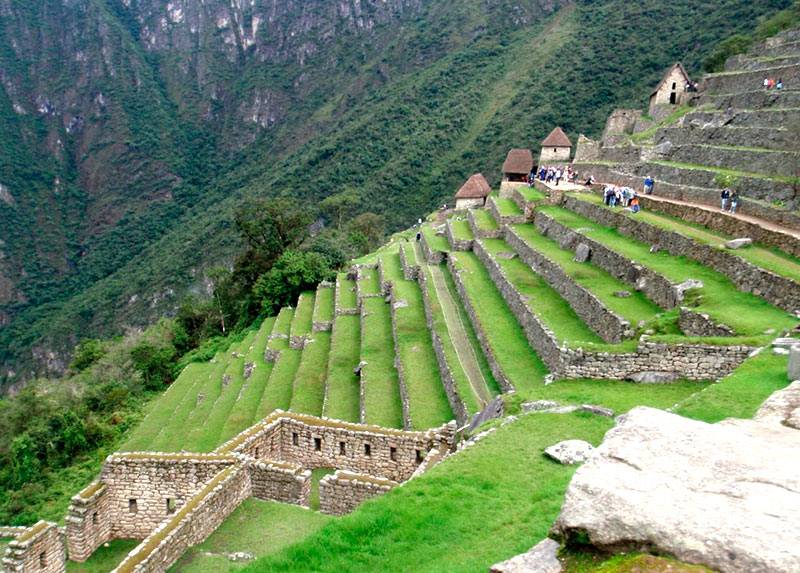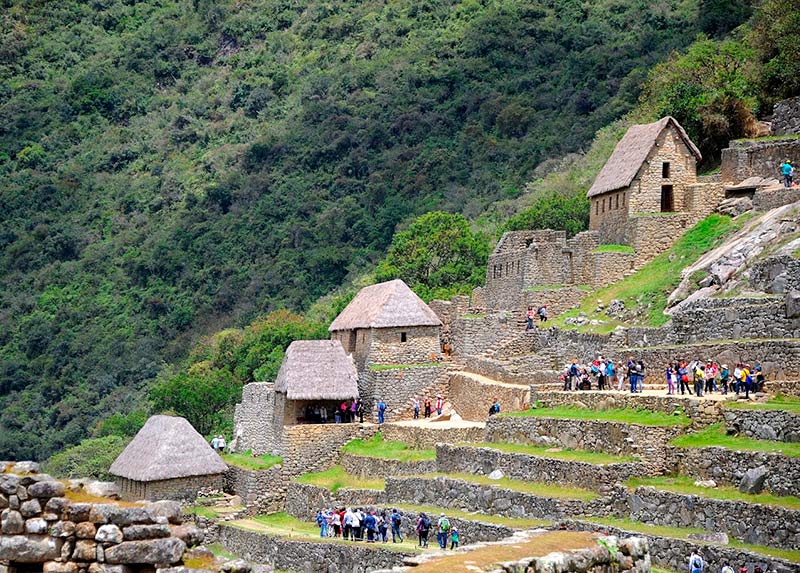The platforms or agricultural terraces in Machu Picchu
Machu Picchu is famous for its beautiful landscapes, its Inca stone constructions and its amazing history. However, the Inca citadel could not exist without its dozens of agricultural terraces. These fulfilled a subsistence function for their population. They also offered an enchanting landscape in harmony with the nature that surrounds the wonder of the world. Learn more about the importance of the platforms of Machupicchu!
- Machu Picchu, a masterpiece of agricultural engineering
- The agricultural terraces at Machu Picchu
- Where to see the terraces of Machu Picchu?
- History of the construction of the terraces at Machu Picchu
- With which entrance to visit the terraces of Machu Picchu?
- Visiting hours
- More information about the terraces and agricultural terraces
- Frequently asked questions about the Machu Picchu terraces

Agricultural platforms – Machu Picchu
The Incas built agricultural terraces along the length and breadth of their vast empire. The objective was to gain land for agricultural production. That is why today only in Cusco it is possible to appreciate immense Andes in archaeological sites such as Pisac, Ollantaytambo, Chinchero, Moray, Tipon, Inkilltambo, Choquequirao and more. As well as these Inca sites, Machu Picchu possesses an impressive footpath system.
Machu Picchu, a masterpiece of agricultural engineering
- Machu Picchu is a masterpiece of agricultural engineering. The key to achieving this distinction is the perfection of its agricultural terraces, which remain solid to this day.
- The platforms are wide steps built on the slopes of the mountains. Its function was to support the Inca citadel. However, his main contribution was to gain land for agriculture.
- Each terrace has an internal drainage system that prevents it from collapsing and falling, mainly during the rainy season (it is estimated that it rains 2 thousand cubic millimeters a year in the area). This was achieved thanks to its interior construction in three layers : mulch, sand and gravel.
- Agricultural terraces also fulfill an important ornamental function. Today the beautiful landscape of Machu Picchu would not be the same without the immense terraces spread out at its feet.
The agricultural terraces at Machu Picchu
- It is estimated that in the Historic Sanctuary of Machu Picchu there are up to 4.9 hectares of agricultural terraces.
- All the platforms have a slight incline with the function of draining the water from Machu Picchu. This stair drainage system divided the urban area from the agricultural area and was always evacuated from the citadel.
- Agricultural terraces have a solid structure. It is not possible to imagine the existence of Machupicchu without the construction of these terraces.
Where to see the terraces of Machu Picchu?
- The platforms of Machu Picchu are present both in the agricultural sector and in the lower part of the urban sector of the Inca citadel.
- Also, it is possible to appreciate agricultural plains in part of the mountains Huayna Picchu and the mountain Machupicchu.
- It is estimated that there are still agricultural areas to recover in Machu Picchu. The investigation works continue inconclusive until today.
History of the construction of the terraces at Machu Picchu
- It is estimated that the platforms of Machu Picchu were the first buildings built in the Inca city by order of Emperor Pachacutec in the mid-fifteenth century.
- In the middle of the sixteenth century, due to the Vilcabamba Wars between the Spanish and the Incas; Machu Picchu was abandoned. In the following three centuries the platforms were covered by weeds and thick vegetation.
- In 1911 the American explorer Hiram Bingham arrived at the Inca citadel with the help of local people. The first photos show the abandonment of the site.
- Since then, work began to enhance Machu Picchu. The dense vegetation was cut revealing the magnificence of the platforms. To this day, they are in a good state of preservation. The reason? The magnificent skill of the Incas to build this type of terraces.
With which entrance to visit the terraces of Machu Picchu?
- You can visit the platforms and terraces of Machu Picchu with any of the 5 types of tickets available: a) Machupicchu Only ticket, b) Machupicchu ticket with Huaynapicchu, c) Machupicchu ticket with Mountain, d) Machupicchu ticket with Huchuypicchu and e) ticket Machupicchu with Inca Bridge.
Visiting hours
- You can visit the platforms and terraces of Machupicchu at any of the available times: Monday to Sunday from 6 am to 5 pm.
More information about the terraces and agricultural terraces
- It is forbidden to circulate freely on the platforms of Machu Picchu. There are only a few terraces that allow the passage of tourists in an orderly manner.
- The platforms have dimensions that vary according to their location in the citadel. In general, they have a height of approximately 2 meters and a length that reaches 100 meters in the lowest part of the enclosure.
- The platforms of Machu Picchu served as a food source since the Incas cultivated various products such as corn, quinoa, cotton, pumpkin and even coca leaves.

Colcas or agricultural warehouses – Machu Picchu
Frequently asked questions about the Machu Picchu terraces
1. How many Andes are there in Machu Picchu?
It is estimated that there are approximately 4.9 hectares of agricultural terraces in the entire Machu Picchu Historic Sanctuary.
2. How were the Andes of Machu Picchu built?
The platforms of the Inca city were built using the slopes of the mountains. Its interior has three layers: one of humus, one of sand and another of gravel. Inside, they also built holes and small conduits that channeled the water.
3. What ticket can I use to visit the Andes in Machu Picchu?
The Andes can be visited with any of 5 types of tickets to Machupicchu: a) Machupicchu Only ticket, b) Machupicchu ticket with Huaynapicchu, c) Machupicchu ticket with Mountain, d) Machupicchu ticket with Huchuypicchu and e) Machupicchu ticket with Inca Bridge.
4. Can I walk on the dunes in Machu Picchu?
There are some terraces where tourists can walk. However, it is not allowed to damage these structures. There are also agricultural areas prohibited to visitors.
5. What was the function of the Andes of Machu Picchu?
The platforms fulfilled a main food function through the cultivation of agricultural products. It also fulfilled the function of containment against soil erosion. Finally, it had a landscape function in harmony with its surroundings.
6. When were the Machu Picchu Andes built?
It is estimated that the platforms of the Inca city were built by orders of Emperor Pachacutec at the beginning of the fifteenth century (they were the first buildings of Machu Picchu).
7. How much do the Andes of Machu Picchu measure?
The platforms of the Inca city have an average height of 2 meters. The lowest part of the platforms are up to 100 meters long.
8. What are the platforms of Machu Picchu made of?
The platforms are made of an interior base of stone, gravel and sand. This way they managed to avoid erosion because they also had interior channels that channeled the water.
9. What products did the Incas grow on their platforms at Machu Picchu?
The Incas cultivated different types of products on the platforms of Machupicchu, among which the following stand out: corn, quinoa, cotton, pumpkin and even coca leaves.
10. In what tourist attractions of Cusco see Inca Andes besides Machu Picchu?
In Cusco you can see platforms in Inca archaeological sites such as: Moray (circular platforms), Pisac (large stepped platforms), Ollantaytambo (platforms similar to Machu Picchu) and more.
By Ticket Machu Picchu – Last updated, August 15, 2024